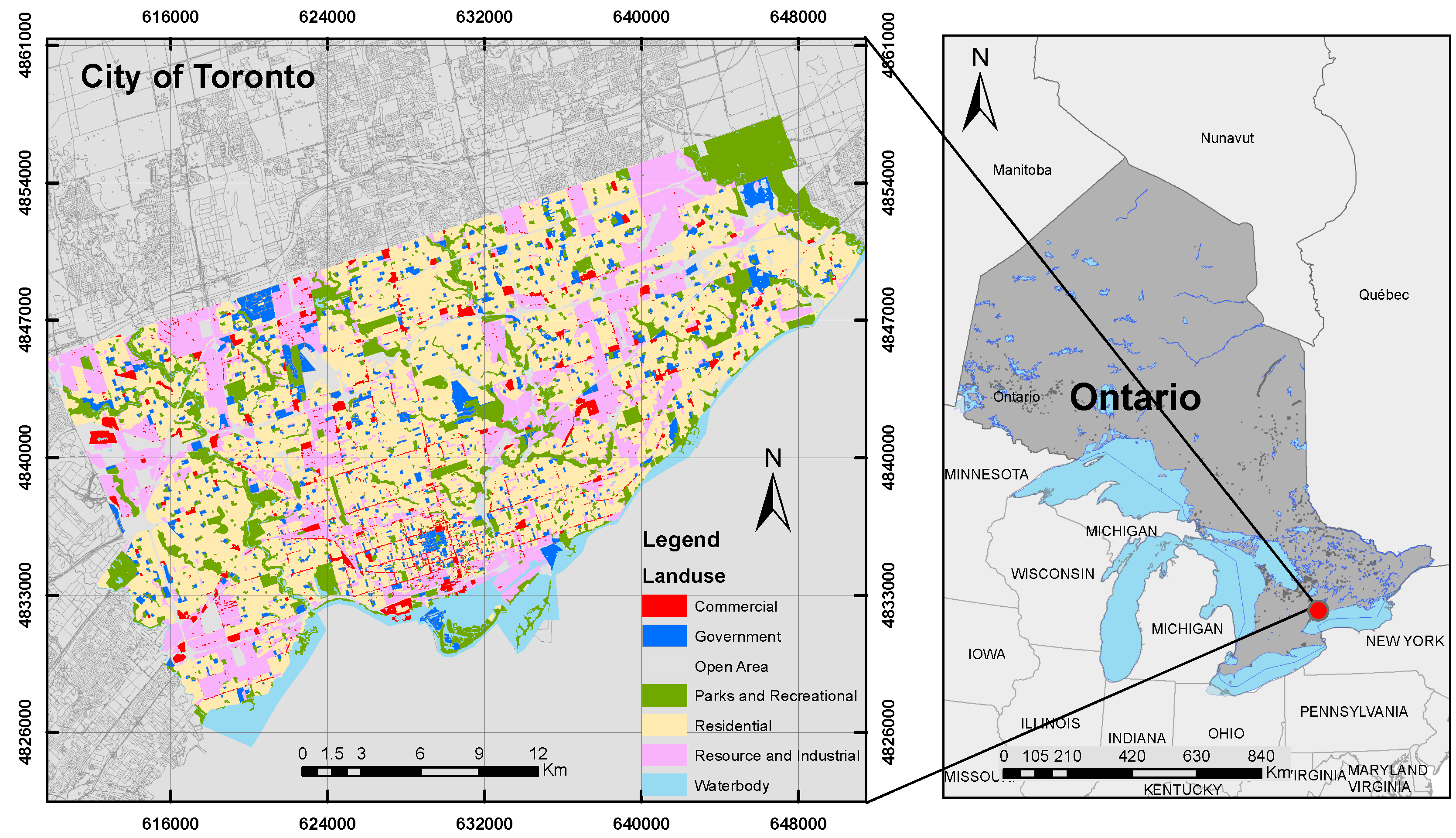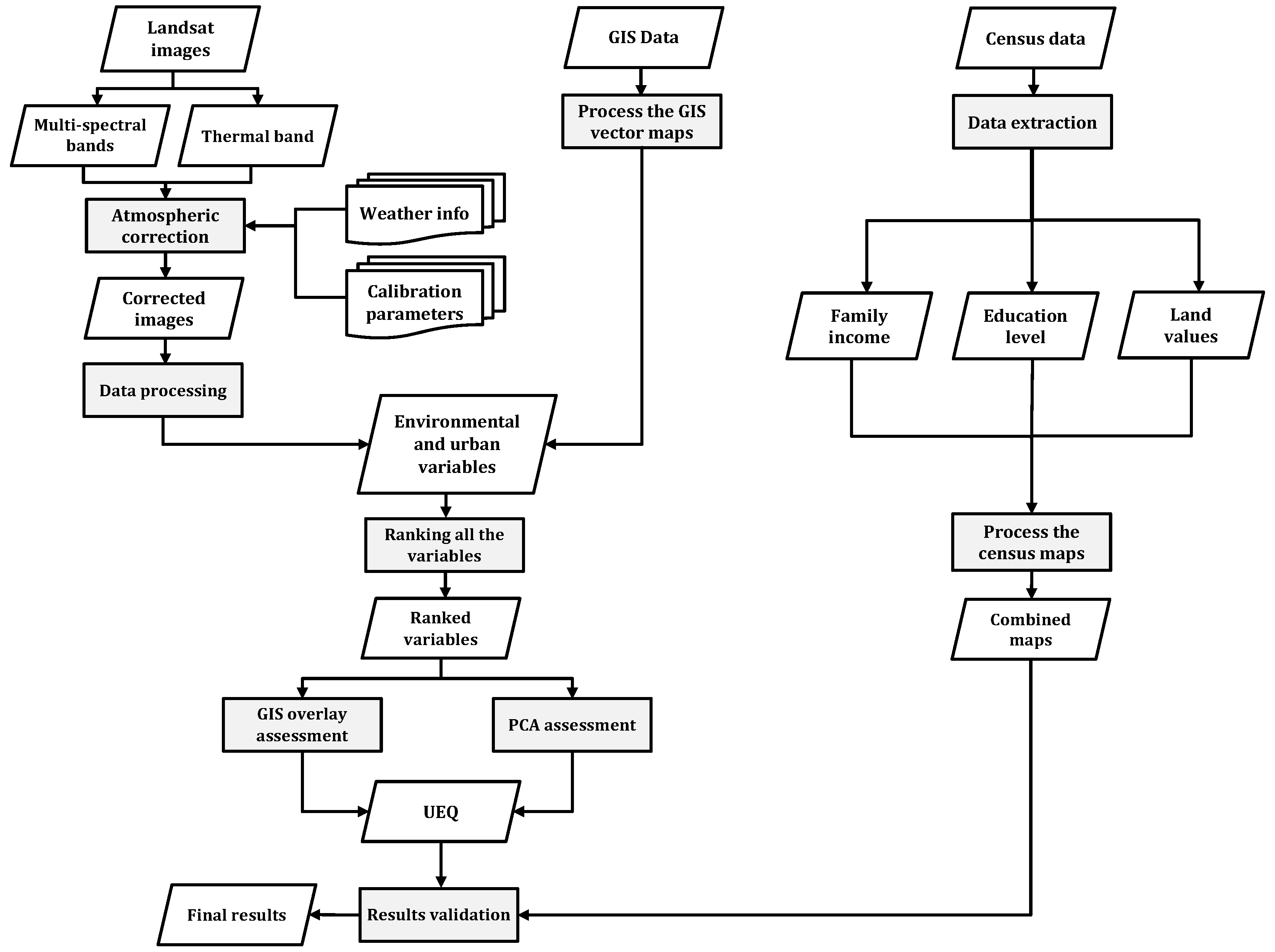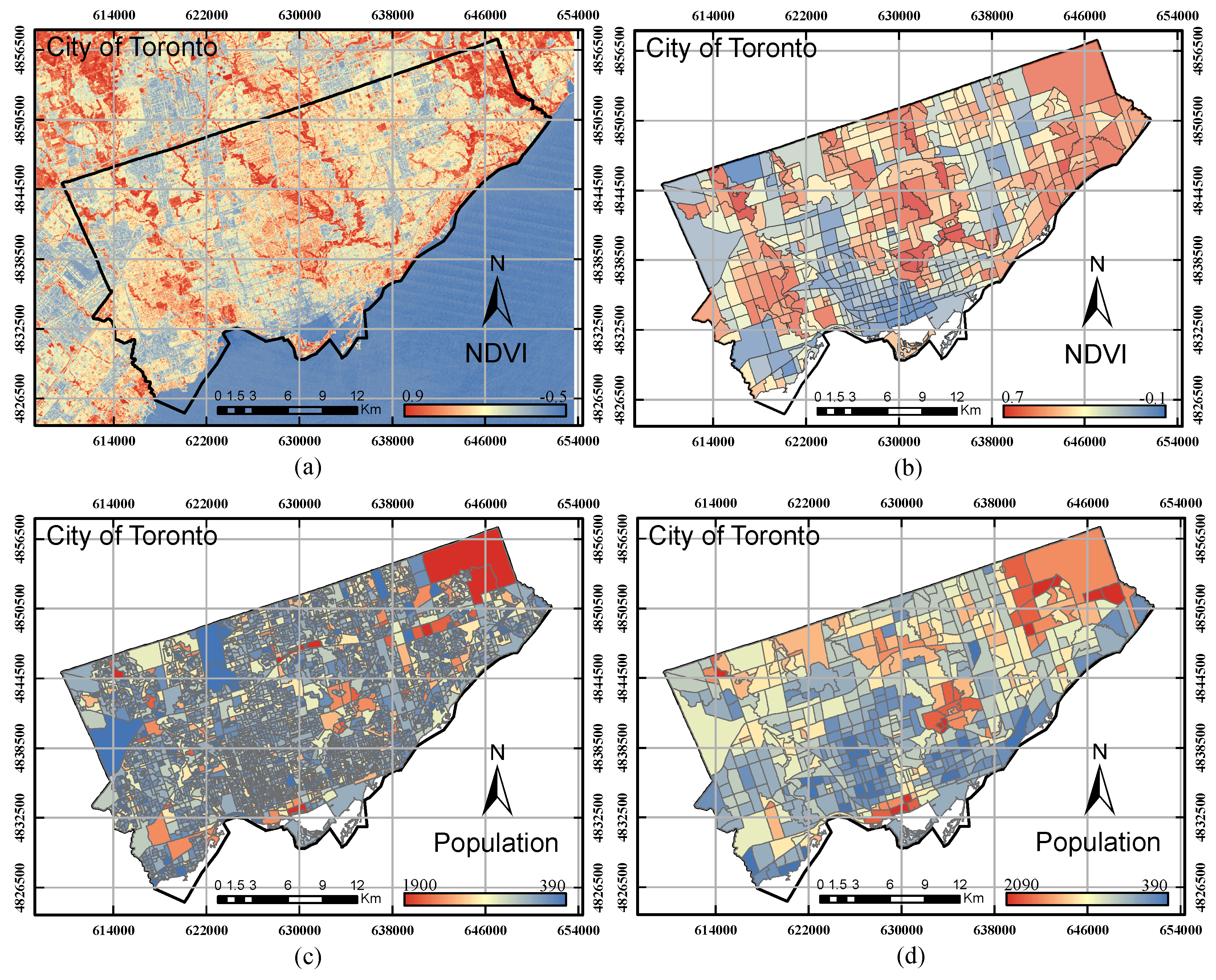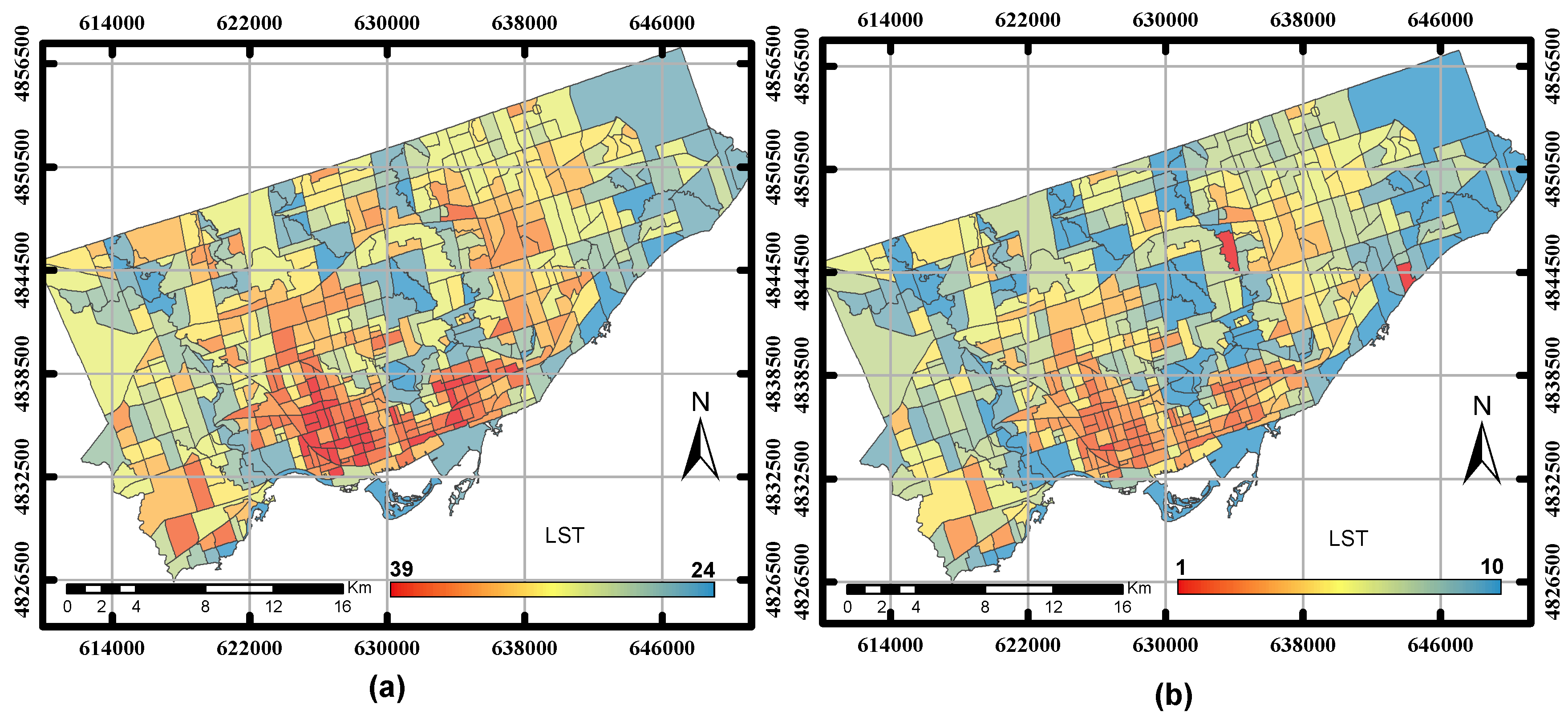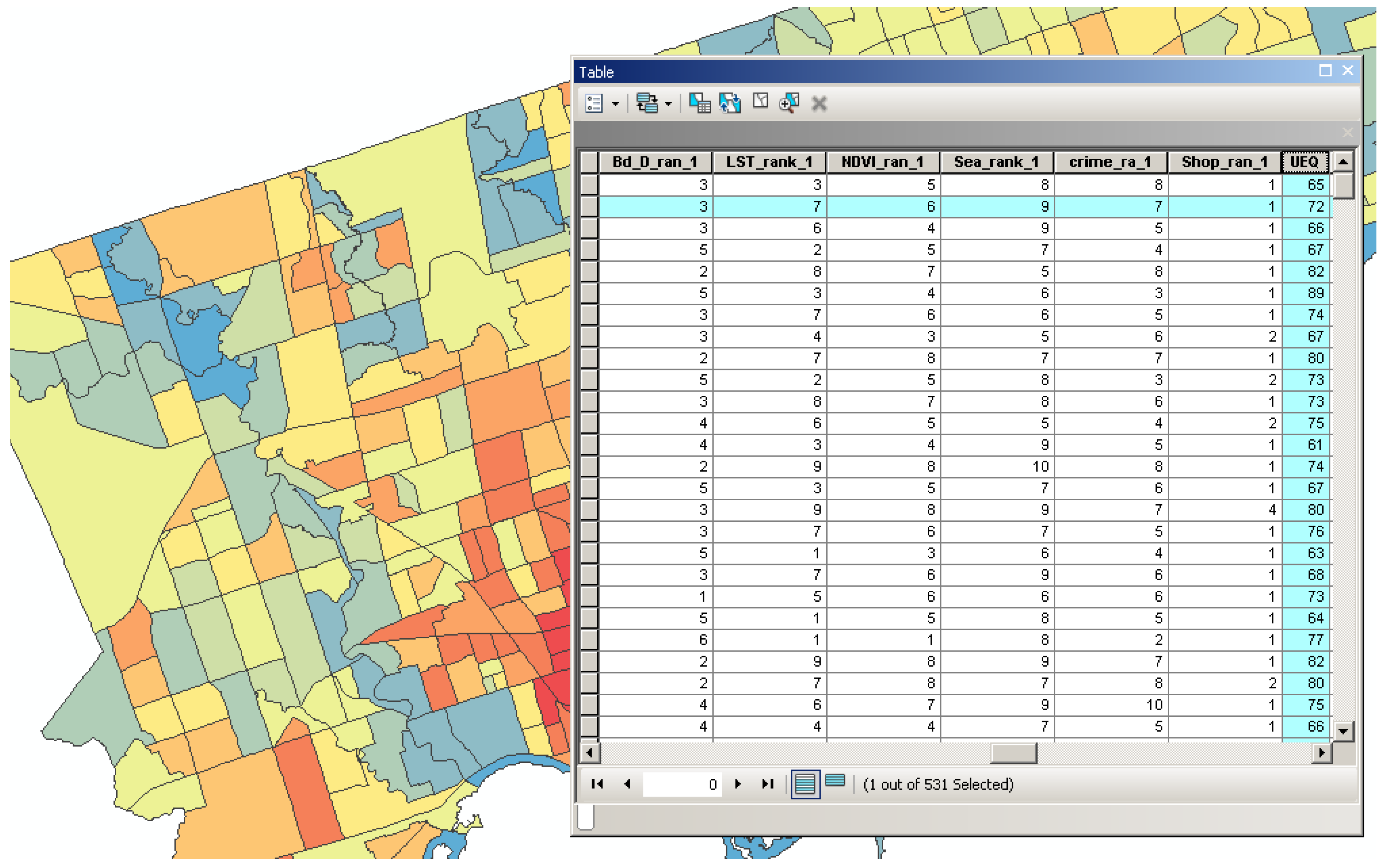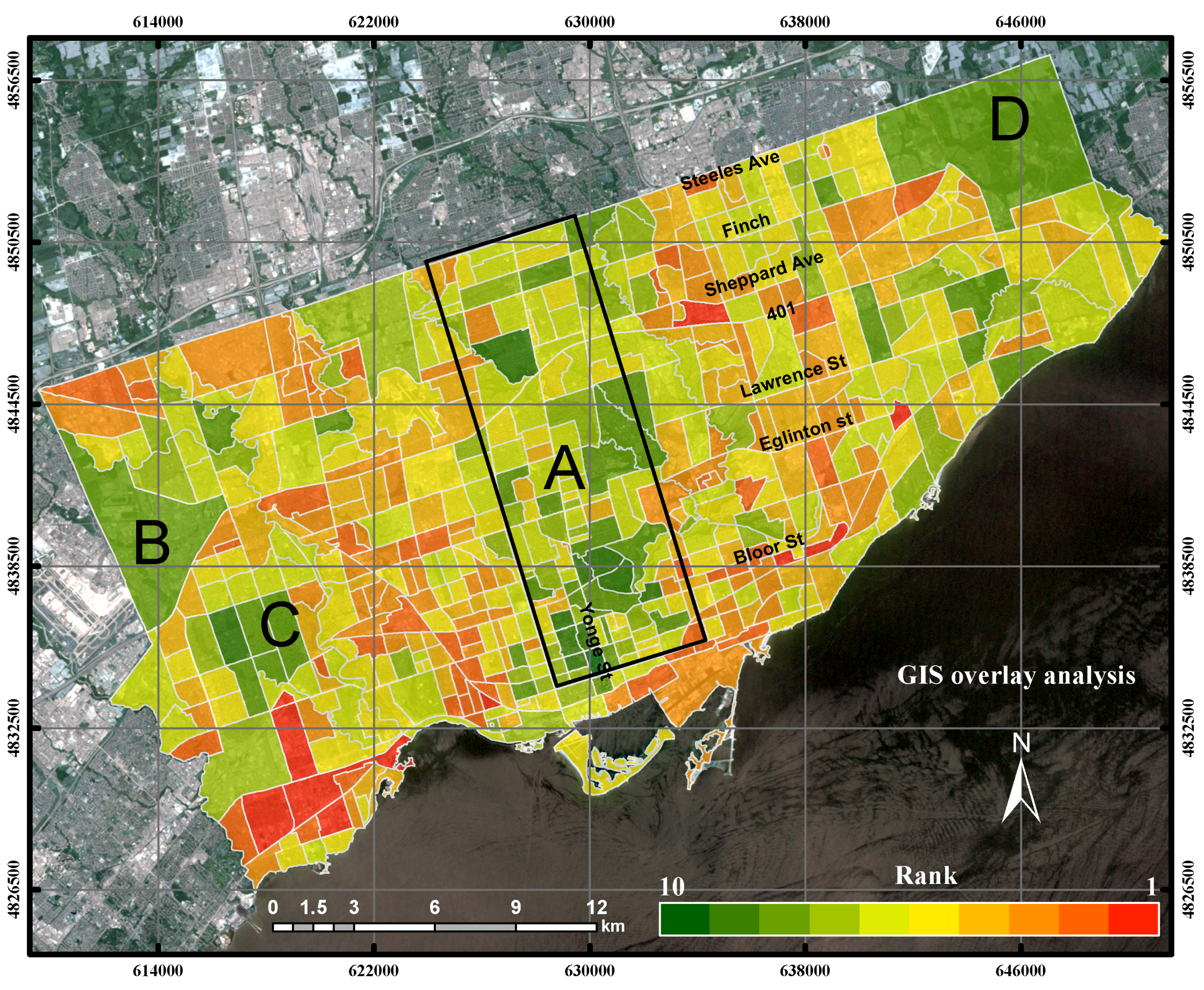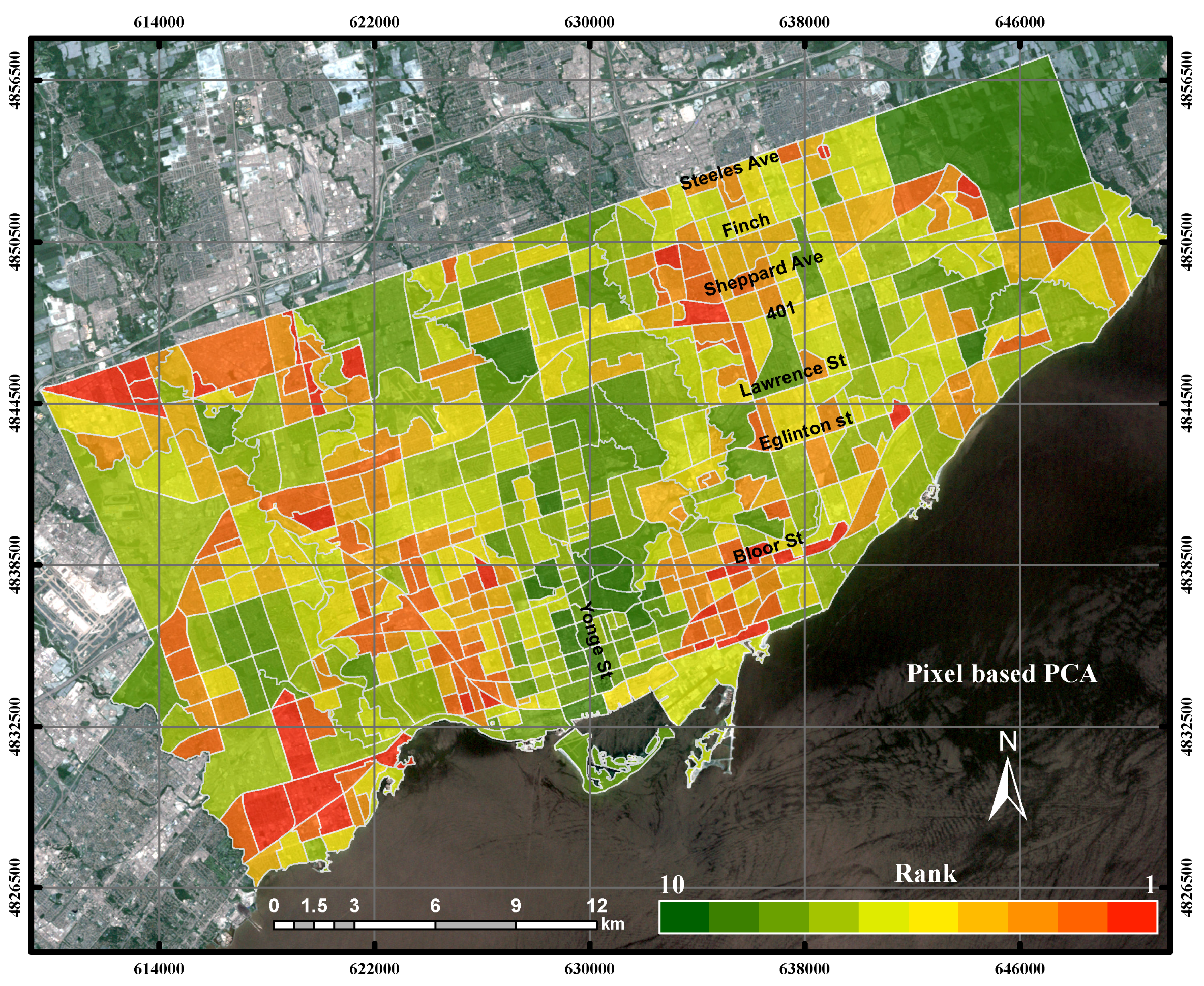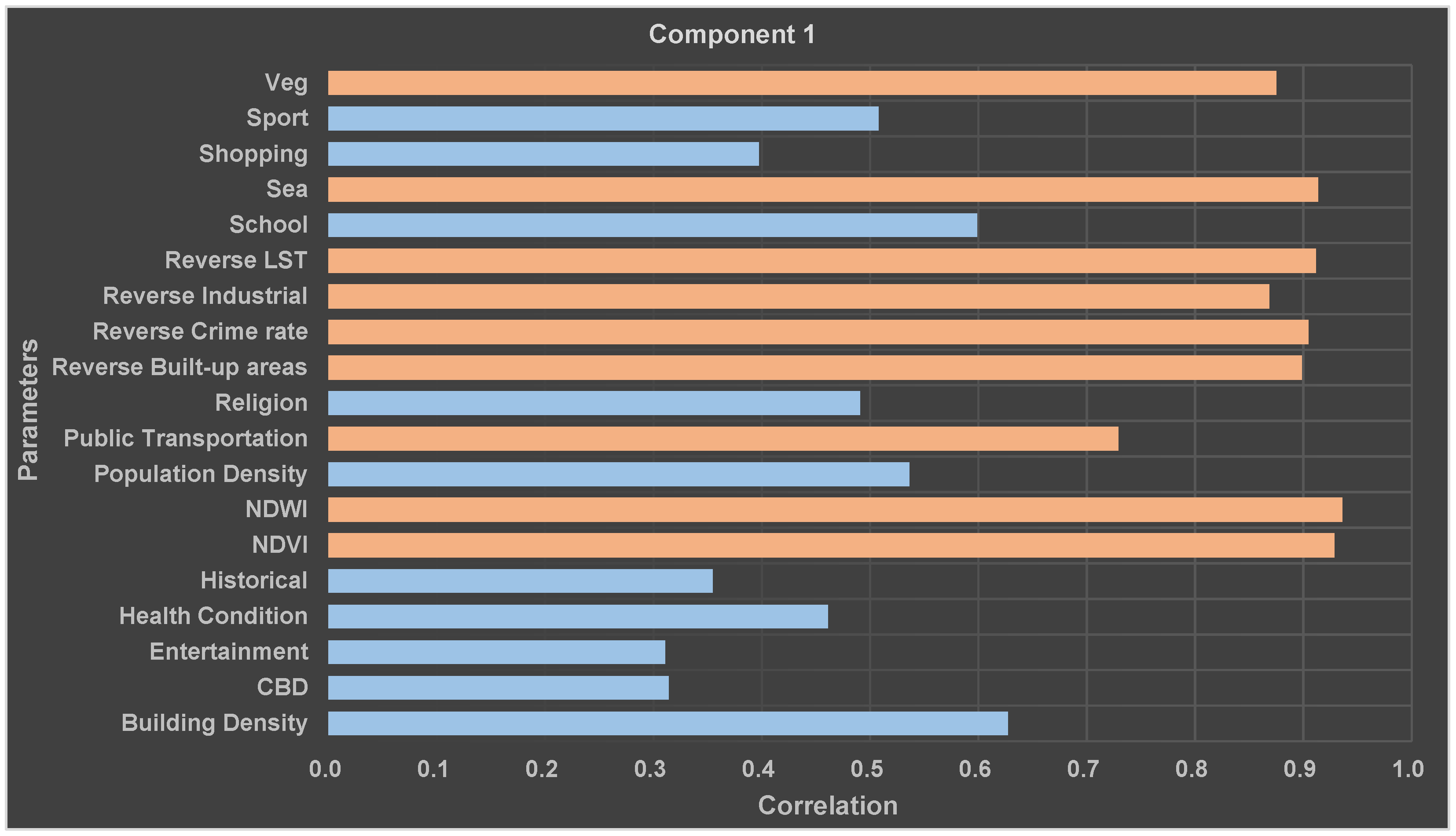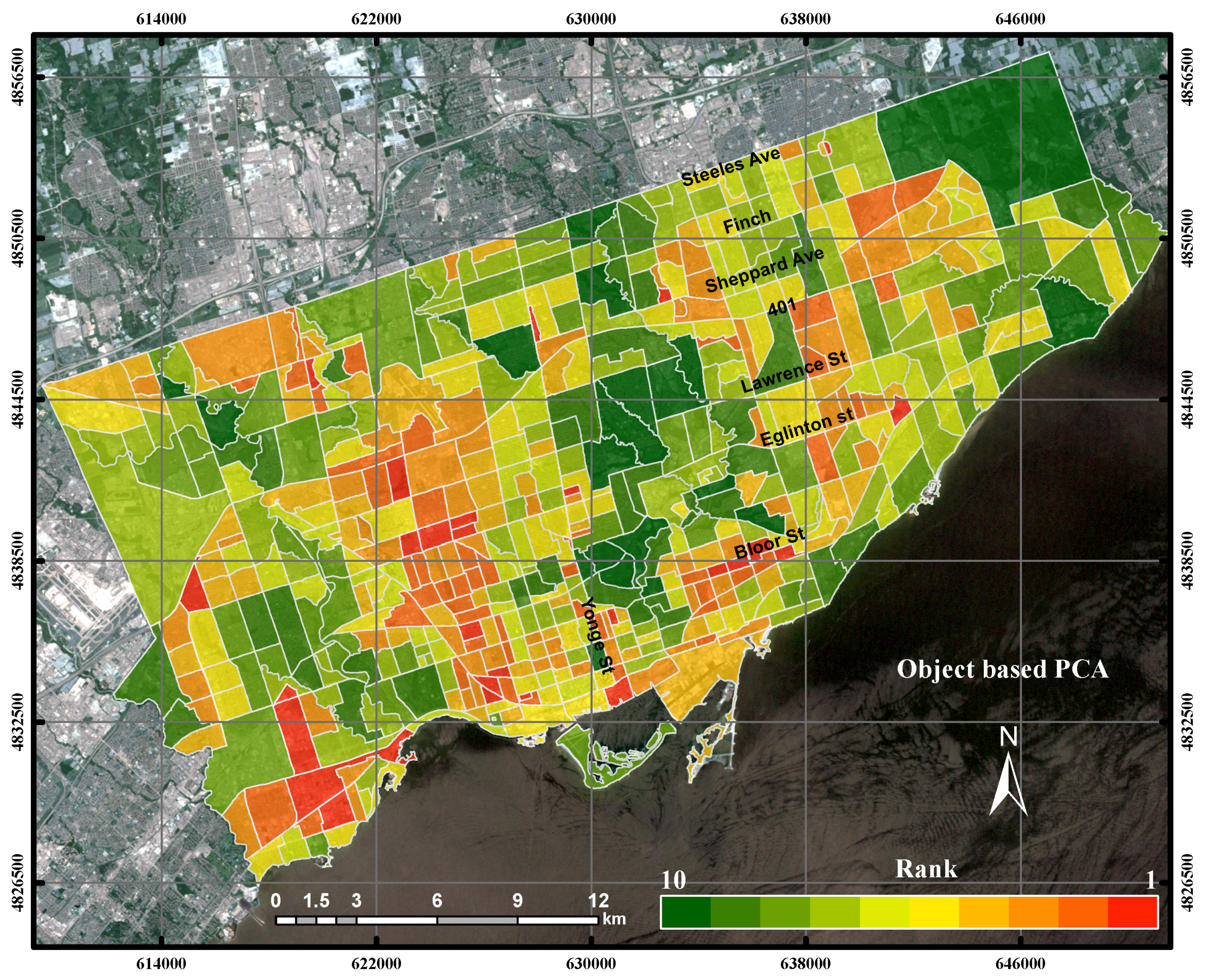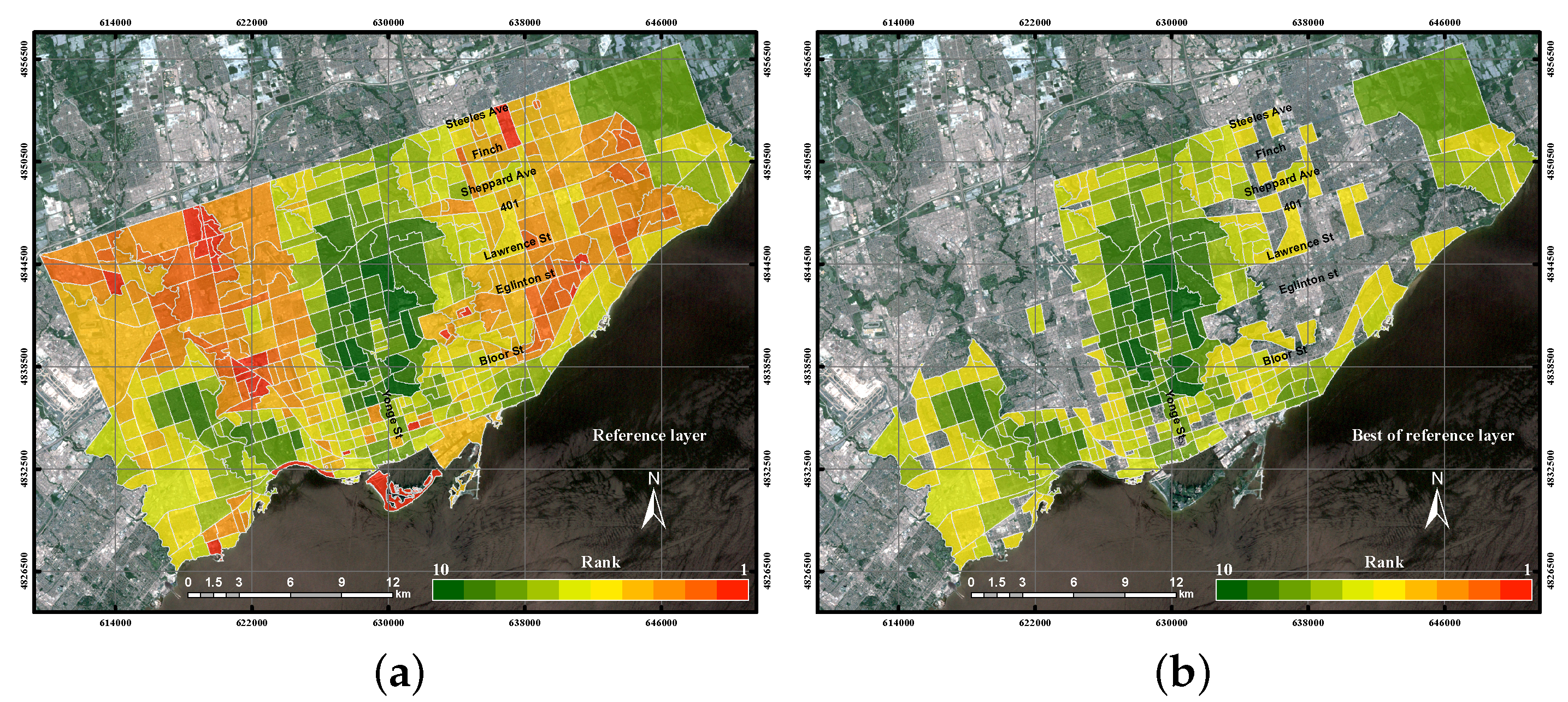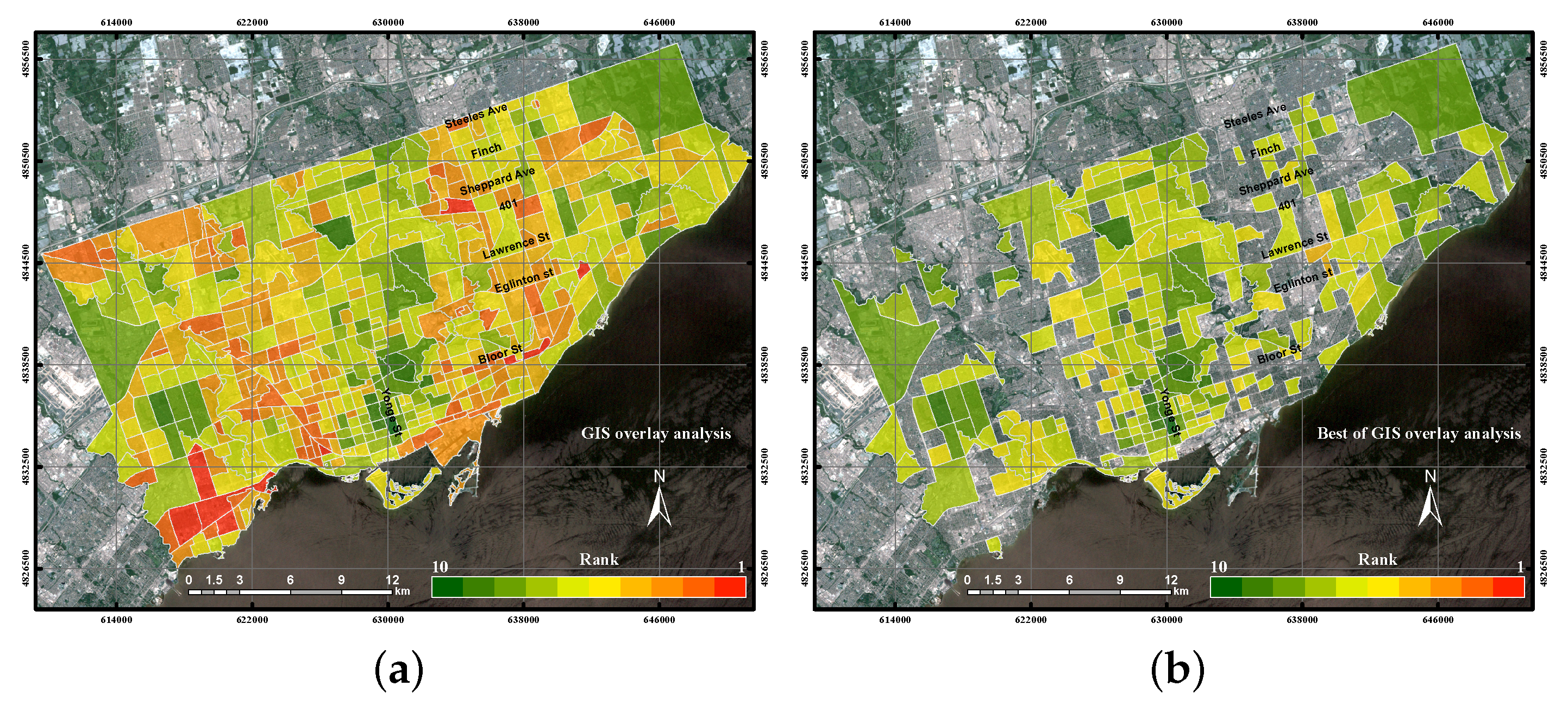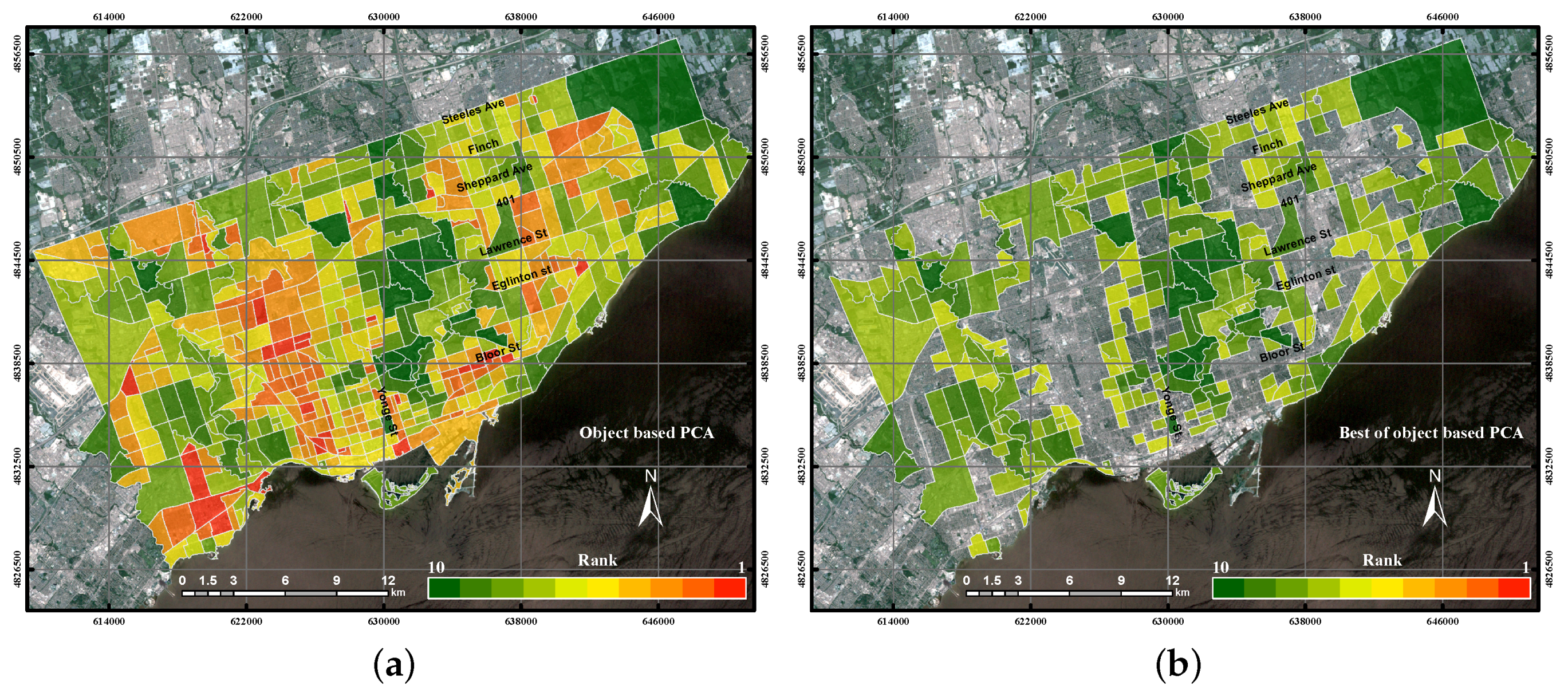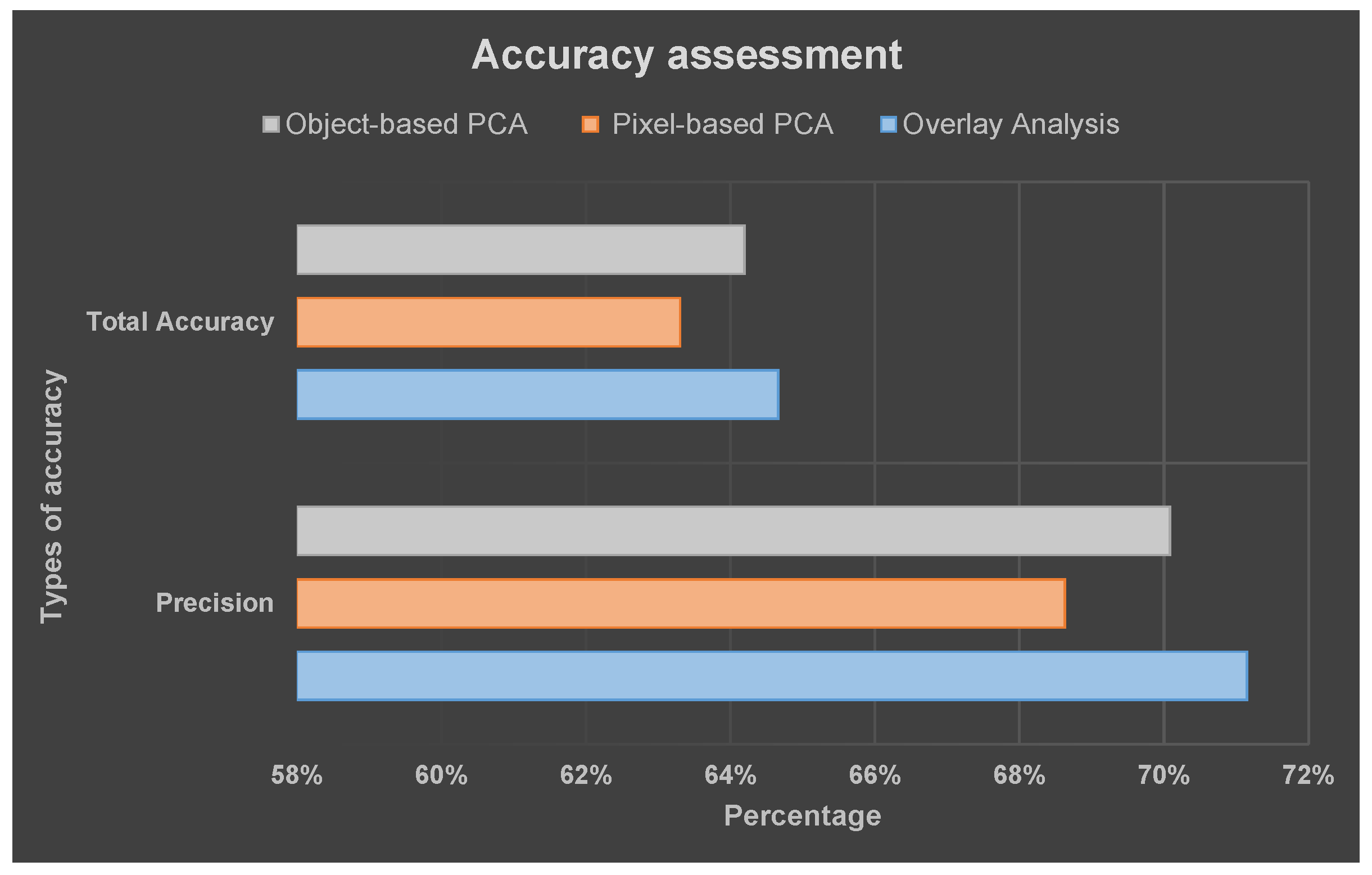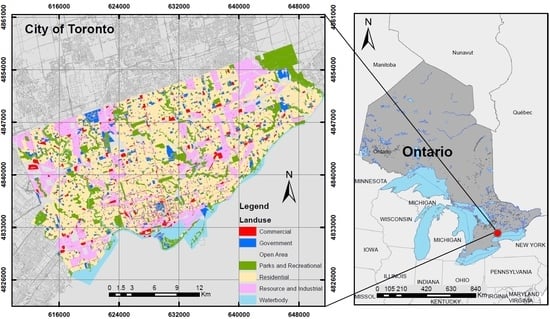1. Introduction
Urban Environmental Quality (UEQ) is defined as an indicator to generically describe the urban, environmental and socio-economic condition of an urban area. UEQ can be regarded as a multilayer concept that comprises physical, spatial, economic and social parameters at different scales [
1]. Weng and Quattrochi [
1] addressed that UEQ has the capability to influence many governing aspects, including urban planning, infrastructure management, economic influence, policy-making and social studies. However, it is challenging to predict and model the inter-relationship and dependence of all of the factors. Recently, satellite remote sensing techniques can help in modelling UEQ through providing continuous Earth observation images of the urban environment at different spatial, spectral and temporal resolutions [
2,
3,
4]. A few preliminary attempts were found using multi-temporal and multi-resolution data to model UEQ [
5,
6,
7,
8], since these data can provide a clear vision for visualizing and understanding the land cover, water conditions and vegetation in urban areas [
9,
10]. As such, UEQ assessment not only provides more detailed information toward urban conditions, it also serves as an efficient tool in sustainable development and urban planning. Subsequently, a number of representative studies were found in the literature that demonstrated how to use multi-source data to model and assess the UEQ.
Nichol and Wong [
8] conducted a research study in the Kowloon Peninsula, Hong Kong. The main goal of the study was to investigate different ways of combining six parameters (vegetation density, heat island intensity, aerosol optical depth, building density, building height and noise) in different units into a single integrated UEQ index and to establish a suitable mapping scale at which these parameters operated and interacted. The study was conducted at two scale levels through using a high resolution IKONOS satellite image and a fine resolution Landsat satellite image. Two approaches, including Geographic Information System (GIS) overlay analysis and Principal Component Analysis (PCA), were used to integrate these six parameters. To act as a reference of UEQ assessment, an email questionnaire survey was conducted with 200 Kowloon Peninsula residents to weight the parameters. The field-based questionnaire survey was administered at 70 locations during the summer season to validate the results. The results showed that the combined parameters, including vegetation density, building density and building height, are more representative to model the UEQ in Hong Kong. Moreover, the overall result showed that the UEQ result derived by GIS overlay analysis is deemed to be close to the residents’ opinion obtained from the questionnaire surveys.
Liang and Weng [
11] introduced various environmental and socio-economic parameters to assess UEQ changes in Indianapolis, USA, in the past 10 years. A total of 18 environmental parameters, including cropland and pasture, water, forest, grass, barren lands, commercial and industrial areas, high density residential areas, medium density residential areas, low density residential areas, Land Surface Temperature (LST), Normalized Difference Vegetation Index (NDVI), Normalized Difference Water Index (NDWI) and Normalized Difference Built-up Index (NDBI) from transformed bands, were extracted from two Landsat Thematic Mapper (TM) images taken in 1991 and 2000; among which, 13 socio-economic parameters, including population density, median age population, household, house unit, owner-occupied house unit, vacant house unit, median house income, median family income, per capita income, house value, percentage of college graduate, percentage of family under poverty line and unemployment rate, were derived from US census of 1990 and 2000. The results demonstrated that four principal components being extracted can sufficiently represent the 28 parameters. The variance of each component was used as a weight to compute the UEQ for each year. The derived UEQ map showed that medium UEQ zone in 1990 was recognized as poor zones in the 2000. High UEQ areas in 1990 were transformed to medium UEQ areas in 2000. The city centre in 1990 was identified as a mixture of high, medium and poor UEQ. However, in 2000, the city centre became a medium level UEQ zone. The UEQ was significantly improved in the south and the southeast zones over the past ten years in Indianapolis, USA.
Another representative study covered the city of Delhi, India, conducted by Rahman et al. [
12]. The city has been suffering from a dramatic increase of population annually, which has led to environmental and public services degradation. The east district of Delhi had the largest population with 98.75% of the urban population in 2001. The main goal of this case study was to investigate the UEQ in the east district of Delhi. The Advanced Space-borne Thermal Emission Reflection Radiometer (ASTER) image of the year 2003 was obtained to generate the land use/land cover map. The guide map was used to generate the land use/land cover map of year 1982. Supervised classification was conducted based on the maximum likelihood method. Five land classes (named high density residential, medium density residential, low density residential, roads and open green spaces) were extracted from the ASTER image. Socio-economic and environmental parameters, such as built-up area, open spaces, household density, occupancy ratio, population density, accessibility to roads, noise and smell affected area, were used to assess the UEQ of Delhi. GIS overlay was conducted to integrate the urban environmental parameters for the years 1982 and 2003. The result showed that in the year 1982, 89% of the east district of Delhi was in good environmental conditions, while the remaining areas were in fair conditions or bad, alarming conditions. However, in the year 2003, 75% of the east district of Delhi was in good environmental condition, while the areas with poor and bad alarming conditions had increased to 22% and 3.5%, respectively. The reason is mainly due to the unplanned urban extension found within the east district of Delhi. The study demonstrated that remote sensing and GIS data are viable techniques for urban environmental management and decision making.
Rinner [
13] investigated the combination of Geographic Visualization (GeoVis) and Multi-Criteria Evaluation (MCE) methods to assess the UEQ within Toronto. MCE is a weighting method that allows decision makers to modify attribute values of the variables. Numerous socio-economic and demographic variables, including population change, population density, ownership of dwellings, family size, average household income, expenditure on housing, employment status, immigration status and degree of education were used to assess the UEQ. An analytic method, named the Analytic Hierarchy Process (AHP), was investigated to estimate the composite measures of quality of life. The AHP method can be used to visualize the spatial patterns and combine different models for UEQ. Interviews with three senior geography students were conducted to validate the results. The result of this case study is more toward supporting analysts to review their final decision-making strategies.
Despite the above successful attempts, the majority of the UEQ studies utilized PCA or GIS analysis techniques to integrate various parameters [
7,
8,
11,
12]. Although PCA is an analytical technique that compresses the main data into lower dimensions that retain most of the data variance [
14], the method still has several potential drawbacks: (1) it produces unweighted components, which may not represent meaningful parameters; (2) PCA does not work properly in nonlinear relationships; and finally, (3) the minimum number of components is indeterminable. Although some researchers used the GIS overlay method to integrate different parameters [
8,
12], the GIS overlay method does not consider the correlation among the parameters. Each parameter may rank from a certain range, say 1–10, where 1 represents the best condition and 10 represents the worst condition. The sum of the derived parameters corresponds to the UEQ ranking. The GIS overlay method can be used effectively to store, analyse and represent layers from different types of map features [
8]. Regarding the result validation, most of the UEQ studies [
11,
13,
15,
16,
17] did not perform any field survey or even result validation, except very few attempts found using e-mail questionnaire or field-based questionnaires [
8,
12]. Collecting field data is always ideal, but it is also time consuming and budget dependent. Moreover, these methods can be inaccurate to test the outcomes of UEQ if the data samples being collected are not representative, which may lead to bias results.
In this research, the main objectives are: (1) to investigate GIS overlay and PCA techniques to assess UEQ with a case study in the city of Toronto, Ontario, Canada; (2) to test a new approach to normalize the data derived from remote sensing and GIS data; and (3) to assess a new approach to validate the final outcomes derived from GIS overlay and PCA. Thus, various remote sensing and GIS data were first explored in order to fully understand the concept of UEQ. The urban, environmental and socio-economic parameters were normalized in this research in order to evaluate the significance of each parameter. GIS overlay and PCA (pixel-based and object-based) were introduced to integrate the urban, environmental and socio-economic parameters with a case study in Toronto. Socio-economic parameters, including family income, degree of education and land value, were used as a reference to validate the outcomes derived from the two integration methods.
2. Datasets
In this research, the city of Toronto, Ontario, Canada, was intentionally selected due to the data availability and the drivers of the population growth within the city during the past decade.
Figure 1 shows Toronto, which is the capital of the Province of Ontario and the largest city in Canada with a total population of 2,615,060 [
18]. The datasets being used in this study include three major categories: (1) Landsat TM satellite images; (2) GIS data layers; and (3) socio-economic data. All of the data were collected in the years 2010 and 2011, since GIS data and socio-economic are not consistently available after the year 2011. A Landsat TM image was downloaded from the United States Geological Survey (USGS) Earth Explorer [
19]. The spatial resolution of the Landsat images is 30 m for the multi-spectral bands and 120 m for the thermal band. However, the thermal band was resampled to a 30-m resolution from the source of the data predominantly to align it with the multi-spectral bands [
20]. The image was acquired during the summer season (July) in order to avoid the appearance of clouds and snow cover. On the other hand, a total of 14 GIS data layers were acquired from the Scholars GeoPortal [
21] for Toronto during the same period of time. The GIS layer data including land use, population density, building density, vegetation and parks, public transportation, historical areas, Central Business District (CBD), sports areas, religious and cultural zonse, shopping centres, education institutions, entertainment zones, crime rate and health condition. These layers were first imported into the ArcGIS platform (
ArcGIS; Esri; Redlands, CA, USA) for further analysis. Similar to the remote sensing data, all of the data were projected to the Universal Transverse Mercator (UTM) 17 N coordinate system. Those social-economic parameters were derived based on the use of Toronto census data that were obtained from the City of Toronto census bureau at the census tract level. The City of Toronto census bureau archives hundreds of information related to socio-economic conditions. In this research, the socio-economic parameters included education (university certificate, diploma or degree), family income and land values.
Table 1 summarizes the data sources being used in this study.
5. Conclusions
In summary, this study aimed to utilize remote sensing and GIS techniques to assess UEQ with a case study in the city of Toronto, Ontario, Canada, through evaluating two methods: GIS overlay and PCA. One of the issues for the UEQ integration method is that remote sensing, GIS and census data are collected at different scales and in different formats, which may require data normalization before further analysis. In this study, The Z-score model was performed as a first step to normalize all of the parameters. Then, linear interpolation was implemented to rank all of the Z-score values from 1 to 10.
Integration techniques including GIS overlay and PCA (both pixel-based and object-based methods) were used to integrate the environmental, urban and socio-economic parameters. GIS overlay is one of the effective tools for integrating different datasets from different data sources. GIS overlay offers an intelligent platform for creating a comprehensive database to evaluate the UEQ. Correlation analysis investigates the dependence found among urban, environmental and socioeconomic parameters. In our case study, it was found that green areas have a strong positive correlation with NDVI and NDWI. There was a negative relationship with the built-up areas parameter, LST, industrial areas, crime rate and building density. Alternatively, PCA provides an efficient method to reduce the data dimension and redundancy. Four components that have eigenvalues over one were derived from the 19 parameters that represented the urban and environmental aspects in the pixel-based PCA method. Five components that have eigenvalues over one were derived from the 19 parameters that represent the urban and environmental aspects in the object-based PCA method. The two methods (pixel-based and object-based) were tested due to the data availability. Other studies can only consider one method of PCA, since they do not have significant contrast in the results with respect to UEQ parameters.
One of the key concerns in UEQ research is to validate the final results derived from different socio-economic references. Despite that some of the existing UEQ studies utilized email or questionnaire surveys to collect the public’s opinion for UEQ assessment, this study proposed to use three socio-economic parameters (university certificate or diploma, family income and land values) as a reference for result assessment. The results showed that the precision was 71% for the GIS overlay method, and the accuracy was measured as 65%. The precision level of the pixel-based PCA method yielded 68%, and the accuracy was reported to be 63%, respectively. The precision level of the object-based PCA was 70%, where the accuracy was reported to be 64%. In this study, GIS overlay represented better results than PCA (pixel-based and object-based) with respect to the UEQ results parameters, which may suggest that GIS overlay can be a better method in terms of the integration of multiple parameters.
Although the presented approach can be used by any federal authorities and municipalities in developing and developed countries, where there is a need to improve and design the new areas within the city, there are a few recommendations for similar future studies: (1) more up-to-date remote sensing and GIS data are required to consolidate the findings; (2) census socioeconomic data usually relate to administrative units and can be changed in a shorter period of time, which makes it difficult to be available worldwide; (3) integration among remote sensing, GIS and socioeconomic data needs conversion between data, such as from raster to vector or from vector to raster, a step that may cause a certain loss of spatial information. To conclude, remote sensing and GIS techniques can provide fruitful information to model UEQ. However, other urban and environmental parameters, as well as empirical models (such as different geographically-weighted approaches) should be considered in order to develop a more universal indicator to predict the UEQ. As a result, further research is under way to study different approaches to narrow down the variety of parameters, as well as developing a new technique to retrieve the UEQ in different cities located in Canada.
